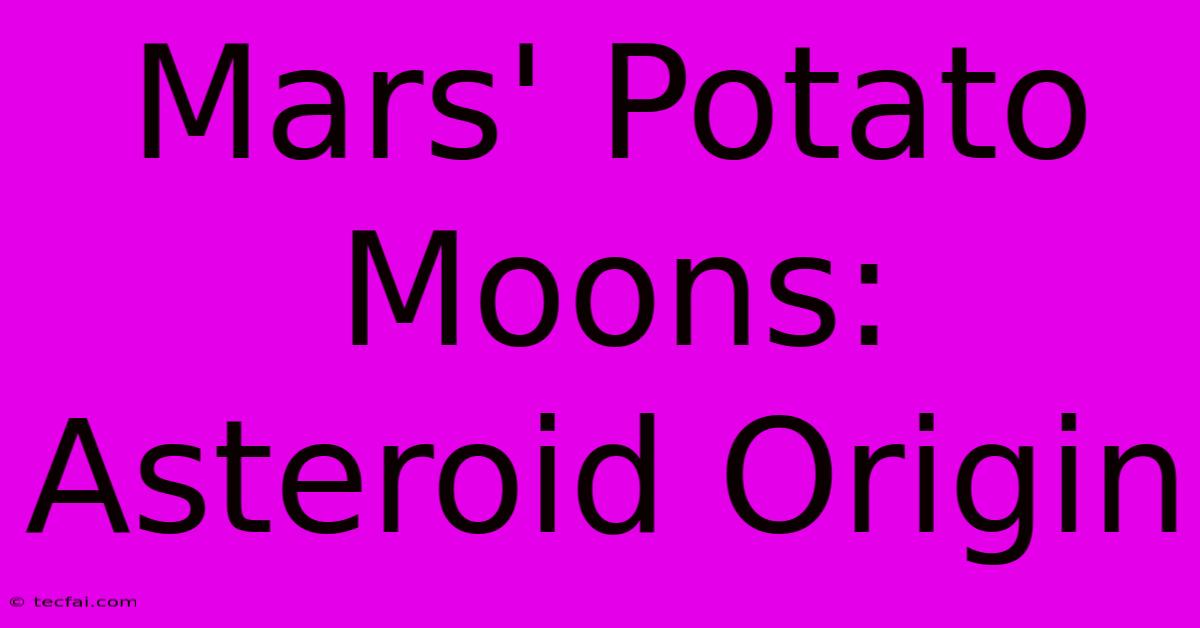Mars' Potato Moons: Asteroid Origin

Discover more detailed and exciting information on our website. Click the link below to start your adventure: Visit Best Website tecfai.com. Don't miss out!
Table of Contents
Mars' Potato Moons: An Asteroid Origin Story
Mars, the rusty red planet, isn't alone in its celestial neighborhood. It boasts two small, irregularly shaped moons: Phobos and Deimos. Often described as "potato-shaped," these intriguing celestial bodies have captivated scientists for decades, leading to ongoing research into their origins. While many theories exist, the most widely accepted hypothesis points towards an asteroid capture origin. Let's delve into the evidence supporting this compelling narrative.
The Case for Captured Asteroids
The irregular shapes of Phobos and Deimos are a key piece of evidence. Unlike the smoothly spherical moons often formed alongside their planets, these Martian companions exhibit lumpy, uneven surfaces. This irregular morphology is characteristic of asteroids – rocky bodies formed in the early solar system that lack the gravitational forces necessary to achieve a spherical shape. Planets, on the other hand, usually form with enough mass to overcome their own gravity and create a more rounded form.
Furthermore, the moons' compositions provide additional clues. Spectroscopic analyses reveal that Phobos and Deimos have spectral properties remarkably similar to D-type asteroids found in the outer asteroid belt. These asteroids are dark, carbonaceous objects, aligning with the low albedo (reflectivity) observed on both Martian moons. This compositional similarity strongly suggests a shared origin within the asteroid belt.
The Capture Mechanism: A Gravitational Tug-of-War
The process by which Mars captured these asteroids is believed to have involved a complex interplay of gravitational forces. It's hypothesized that these asteroids, initially orbiting the Sun in the asteroid belt, experienced gravitational perturbations—perhaps from interactions with other celestial bodies like Jupiter or Mars itself—altering their trajectory. This change in orbit could have brought them close enough to Mars for its gravity to capture them, placing them into stable orbits around the planet.
The capture process might have involved a period of orbital decay, where atmospheric drag or other gravitational forces gradually reduced the asteroid's orbital energy, leading to a tighter and more stable orbit around Mars. This complex process, involving multiple factors and delicate gravitational interactions, makes the capture scenario a plausible explanation.
Alternative Theories and Ongoing Research
While the asteroid capture theory holds the strongest scientific support, other hypotheses continue to be explored. One less prevalent theory suggests that Phobos and Deimos could have formed in situ, simultaneously with Mars. However, this theory struggles to explain the irregular shapes and compositional similarities to asteroids.
Ongoing research, utilizing data from various spacecraft missions to Mars, is further refining our understanding of these fascinating moons. Future missions may provide more precise measurements of their composition and internal structure, strengthening or challenging existing hypotheses. Advanced spectroscopic analyses could unveil more detailed information about their mineral composition, further solidifying their link to the asteroid belt.
Conclusion: A Captivating Story of Celestial Origins
The prevailing scientific evidence strongly indicates that Phobos and Deimos, Mars' "potato moons," originated as asteroids captured by the planet's gravity. Their irregular shapes, spectral similarities to D-type asteroids, and the plausible mechanism for capture all contribute to a compelling narrative of their origins. As research continues, we can anticipate further advancements in our understanding of these enigmatic celestial bodies, unraveling more secrets of the Martian system and the early solar system's dynamic history. This ongoing investigation highlights the captivating nature of planetary science and the continuous efforts to understand the intricate processes that shaped our solar system.

Thank you for visiting our website wich cover about Mars' Potato Moons: Asteroid Origin. We hope the information provided has been useful to you. Feel free to contact us if you have any questions or need further assistance. See you next time and dont miss to bookmark.
Featured Posts
-
Live Ding Liren In World Chess Championship Game 2
Nov 26, 2024
-
Qantas Melbourne Airport Fog Causes Delays
Nov 26, 2024
-
Celtics Timberwolves Panahon Odds 2024
Nov 26, 2024
-
2025 Uk Bank Holiday Chances
Nov 26, 2024
-
16 Missing After Egypt Boat Disaster
Nov 26, 2024
